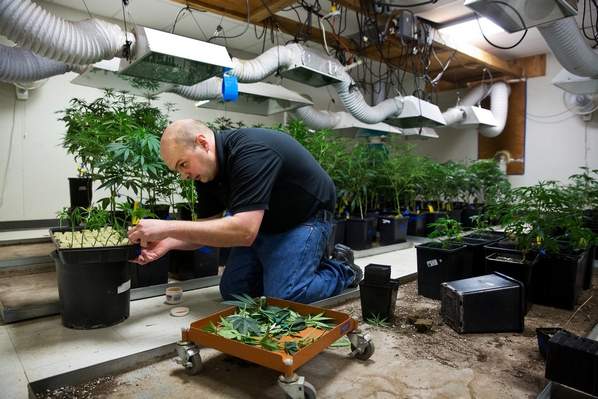The General
New Member
Four years ago in Colorado, pot trounced latte in a head-to-head storefront count. Starbucks had 209 franchises in the state. Denver alone had 390 medical marijuana dispensaries operating with no regulations. Los Angeles once had about 1,000 storefront dispensaries unrecognized by state law. A loose system allowed people to stroll in, tell a doctor they couldn't sleep and stroll out with bud. It's little wonder that dispensaries gained a bad name. In five months, Floridians will vote on a medical marijuana system built around controlled dispensaries. Under a proposed constitutional amendment, no one could grow his own. Smokable pot, infused food and liquids could come only from licensed dispensaries.
This strategy follows the premise that licensed dispensaries are easier to monitor than thousands of backyard plots and that problems with early dispensaries stemmed largely from their operation outside the law. "We wanted a tightly controlled and regulated system," said Ben Pollara, director of United for Care, the amendment's sponsor. "Systems where patients are allowed to grow their own, while something that some patients want and may make it cheaper, ultimately is something you cannot get as good a regulatory hold on." Dispensary-based systems are the hot trend. The last 10 states to legalize medical marijuana use them, and states like Oregon and Nevada recently added dispensary regulation.
Many of these systems are not yet up and running, and their track record is thin. Opponents of Florida's Amendment 2 say the proposed law offers too little information about how the system would work, leaving details up to state regulators and judges who would rule on any constitutional challenges. For example, the amendment does not specify how many dispensaries would be allowed in Florida or how close they could locate to schools. Such details should have been included in the amendment so voters would know what they would be getting, said Sarah Bascom, spokeswoman for the Drug Free Florida Campaign. Pollara counters by saying that medical marijuana systems require pages and pages of regulations, too many to put on a ballot. "I trust that Florida officials will do the right thing," he said.
Early medical marijuana states allowed patients or designated caregivers to grow their supply. In some states, this offered quasi-legal cover for unofficial storefront dispensaries. A customer could designate someone as a caregiver, and caregivers are allowed to possess, grow and supply. With weather, insects and disease making cultivation unpredictable, possession amounts could be generous. Oregon patients and caregivers, for example, could possess six mature plants and up to 2 pounds of dried pot. That meant a dispensary, as caregiver, could grow six plants the size of Christmas trees for each patient, producing much more pot than those patients would ever use. Even running a reputable dispensary risked federal trafficking charges, so the operator had to be willing to skirt the law. Things changed about 2009, when the Justice Department began signaling it would ease off dispensaries if they followed state law.

News Moderator - The General @ 420 MAGAZINE ®
Source: Theledger.com
Author: Stephen Nohlgren
Contact: Contact Us | TheLedger.com
Website: How Might Florida Handle Legal Pot? | TheLedger.com
This strategy follows the premise that licensed dispensaries are easier to monitor than thousands of backyard plots and that problems with early dispensaries stemmed largely from their operation outside the law. "We wanted a tightly controlled and regulated system," said Ben Pollara, director of United for Care, the amendment's sponsor. "Systems where patients are allowed to grow their own, while something that some patients want and may make it cheaper, ultimately is something you cannot get as good a regulatory hold on." Dispensary-based systems are the hot trend. The last 10 states to legalize medical marijuana use them, and states like Oregon and Nevada recently added dispensary regulation.
Many of these systems are not yet up and running, and their track record is thin. Opponents of Florida's Amendment 2 say the proposed law offers too little information about how the system would work, leaving details up to state regulators and judges who would rule on any constitutional challenges. For example, the amendment does not specify how many dispensaries would be allowed in Florida or how close they could locate to schools. Such details should have been included in the amendment so voters would know what they would be getting, said Sarah Bascom, spokeswoman for the Drug Free Florida Campaign. Pollara counters by saying that medical marijuana systems require pages and pages of regulations, too many to put on a ballot. "I trust that Florida officials will do the right thing," he said.
Early medical marijuana states allowed patients or designated caregivers to grow their supply. In some states, this offered quasi-legal cover for unofficial storefront dispensaries. A customer could designate someone as a caregiver, and caregivers are allowed to possess, grow and supply. With weather, insects and disease making cultivation unpredictable, possession amounts could be generous. Oregon patients and caregivers, for example, could possess six mature plants and up to 2 pounds of dried pot. That meant a dispensary, as caregiver, could grow six plants the size of Christmas trees for each patient, producing much more pot than those patients would ever use. Even running a reputable dispensary risked federal trafficking charges, so the operator had to be willing to skirt the law. Things changed about 2009, when the Justice Department began signaling it would ease off dispensaries if they followed state law.

News Moderator - The General @ 420 MAGAZINE ®
Source: Theledger.com
Author: Stephen Nohlgren
Contact: Contact Us | TheLedger.com
Website: How Might Florida Handle Legal Pot? | TheLedger.com


